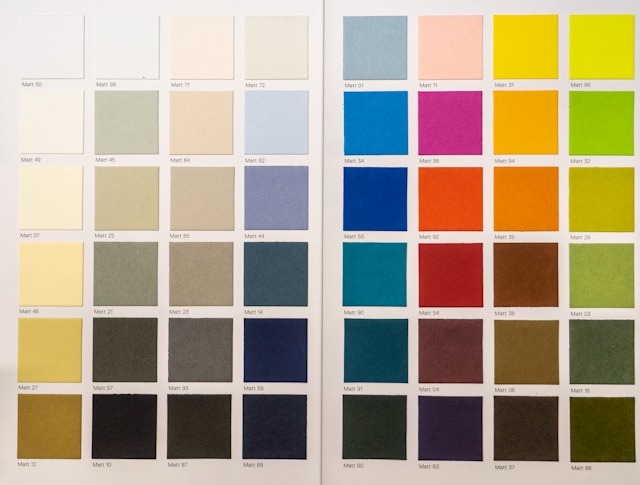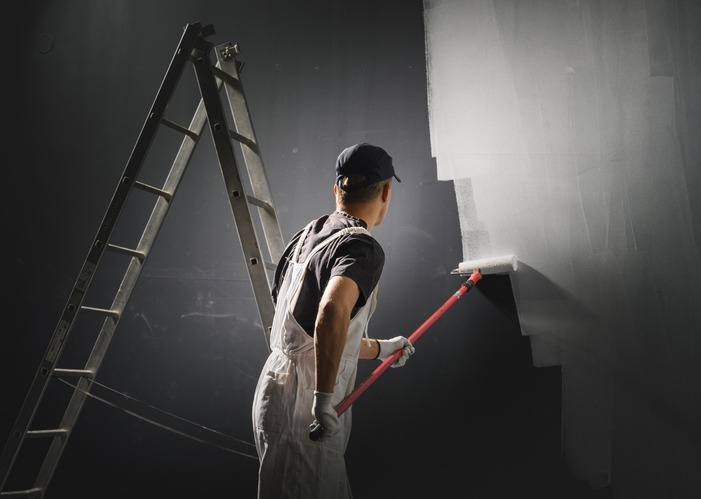To successfully paint over dark colors, start with high-quality white or gray primer, depending on whether you’re going lighter or darker. Opt for acrylic-based paint for better coverage. Prepare your surface by cleaning walls, filling imperfections, and using painter’s tape for clean lines. Apply multiple primer coats, ensuring each layer dries thoroughly. When painting, multiple thin coats work best for a vital finish. Remember, the right tools—a roller with proper nap thickness, for instance—make a smooth process. Drying time is essential for vibrant colors and adhesion. Explore further, and you’ll find more tricks and tips for a flawless transformation.
Key Takeaways
- Use high-quality white primer for better coverage when transitioning from dark to light colors.
- Apply multiple coats of primer and paint, allowing each to dry thoroughly for superior coverage.
- Opt for acrylic-based paint to effectively cover dark walls with lighter shades.
- Prepare the surface by cleaning, filling imperfections, and applying painter’s tape for clean lines.
- Assess wall coverage under different light sources to ensure a smooth and uniform finish.
Choosing the Right Supplies
Choosing the correct supplies is crucial when dealing with the challenge of painting over dark colors. You’ll need the best primer on the market to make sure your lighter color stands out without requiring excessive coats of paint. A high-quality, white primer is your go-to when shifting from dark to light shades, as it reduces the number of topcoats needed. For those moving from light to dark, a gray primer will serve you better, establishing a solid base for your darker hue.
High-quality rollers with the appropriate nap thickness are essential. They ensure smoother, more uniform coats over your dark paint, making the shift to a lighter color less of a hassle. Opt for acrylic-based paint to effectively cover those dark walls. Not only does it adhere well, but it also provides a sustainable option for your project.
Surface Preparation Tips
After selecting the right supplies, it’s time to focus on getting the surface ready for painting. Covering dark colors isn’t just about the paint you use; it’s also about how well you prepare the surface. Begin by thoroughly cleaning the walls. Dust and dirt can hinder paint adhesion, so make sure you’ve got clean walls before you start.
Next, take a close look for any imperfections. Holes, dings, or cracks? No problem. Use spackle to fill them in. Once the spackle dries, it’s important to sand the surface. This step isn’t about stripping the wall but creating a smooth, even base that will make your new color shine.
Don’t forget the importance of painters tape. Apply it along baseboards, window frames, and door casings to keep your paint job sharp and clean. This step protects the adjacent surfaces and ensures a professional-looking finish.
Lastly, remember that proper preparation isn’t just about the walls. Protect your floors and furniture by covering them. It’s these details in surface preparation that pave the way for a successful paint job, especially when tackling the challenge of painting over dark colors.
Selecting the Ideal Primer
Choosing the right primer is essential when you’re shifting from dark to light walls, ensuring that your new color stands out without any remnants of the old hue showing through. When you’re prepared to paint over dark walls, selecting a white primer is your top choice for moving smoothly from dark to light colors. This guarantees superior coverage and color precision. However, it’s not just about applying one coat of primer and considering it done. You need to invest in top-notch primers for a successful finish.
Here’s a brief guide to assist you in visualizing the perfect primer selection:
| Primer Color | Purpose |
|---|---|
| White | Best for shifting from dark to light colors; guarantees superior coverage and color precision. |
| Gray | Ideal for moving from light to dark colors; enhances coverage and depth. |
| White + Paint | Blending a small amount of paint with the primer can achieve the desired shade for the new color. |
| High-Quality | Vital for successful coverage when painting over dark colors. |
| Drying Time | Ensuring thorough drying of the primer is crucial to prevent dark colors from seeping through. |
Application of Multiple Coats
When moving from dark to light walls, it’s vital to apply multiple primer coats to prevent the old color from bleeding through. This step is non-negotiable when you’re changing from dark to light. Each layer of primer must dry thoroughly before you add the next. This guarantees excellent adhesion, establishing a solid foundation for your new color.
After priming, addressing the actual painting involves applying multiple thin coats of paint. This tactic is pivotal when painting over a dark color. Thin layers offer superior coverage and decrease the chances of the paint peeling or chipping later on. Keep in mind, hurrying the process by applying thick layers won’t benefit you. Instead, patience pays off with a smoother, more even finish.
Blending the edges of each coat is another expert tip to embrace. This method helps merge the new paint seamlessly, ensuring there are no abrupt lines or patches. The shift from dark to light then becomes flawless, achieving a professional look.
The number of coats needed can vary, depending on how dark the original color was and how light you want to go. However, with careful application of multiple coats, primer, and strategic blending, you’ll master the art of painting over dark colors.
Technique for Thick Layers
When tackling dark walls, the thickness of your layers matters. You’ll need the right primer to start, followed by strategic application techniques ensuring heavy, even coverage. Remember, allowing adequate drying time between layers is key to a flawless finish.
Choosing the Right Primer
To ensure better coverage on dark walls, you’ll need to choose a high-quality white undercoat. This is essential for a smooth shift from dark to light colors, guaranteeing the paint adheres well and provides a consistent surface. Adding a bit of your desired paint color to the undercoat can refine the shade, making the shift even smoother. However, when going from light to dark, a gray undercoat might be your top choice for improved coverage and color precision. For those persistent dark walls, applying two layers of undercoat is a wise decision. It prevents any dark tones from seeping through, ensuring your new, lighter color stays true and vivid. This step is crucial for achieving a seamless surface and a successful, uniform paint job.
Application Tips & Tricks
Applying thick layers of paint is essential for masking dark walls effectively, guaranteeing your new color pops with vibrancy. When tackling a painting project over a dark color, the shift to a lighter color demands a bold approach. Start with a solid primer foundation; this step can’t be skipped. Then, grab your roller and lay down the paint in generous M or W shapes across the surface. This technique ensures heavy coverage without missing spots. Don’t spread the coat too thin; you’re not saving paint, you’re sacrificing coverage. For those stark dark-to-light switches, adding more layers is your best bet. Each additional coat acts as a barrier, progressively hiding the dark base, transforming your space with every stroke. Precision and patience are your allies here.
Drying Time Considerations
After applying thick coats to conceal dark walls, it’s crucial to consider how long each layer needs to dry.
- Acrylic paint dries in 15-30 minutes, enabling quick layering between coats.
- Proper drying time is essential for a sleek finish, preventing paint pull or peel.
- Allowing layers to dry completely ensures better adhesion, reducing smudging or uneven coverage risks.
- Taking breaks between coats for drying improves adhesion and prevents issues.
- Quick drying time helps manage multiple layers for desired color intensity.
Making sure each layer dries fully before adding another is vital for achieving a flawless finish when painting over dark colors. This method not only aids in maintaining color intensity but also ensures that your efforts result in a smooth, long-lasting finish.
Importance of Drying Time
When you’re painting over dark colors, paying attention to drying time isn’t just useful; it’s essential. Allowing each coat to dry thoroughly before applying the next one prevents smudging and guarantees a smooth finish. Your patience will reward you with a professional look that lasts.
Patience Pays Off
Embracing the wait between paint coats, especially on dark walls, guarantees a finish that’s both smooth and vibrant. Letting each coat dry fully before applying the next is essential. If you rush, you might end up with a paint job that’s less than satisfactory.
- Acrylic paint dries in 15-30 minutes, speeding up the process.
- Proper drying time ensures a flawless finish on dark interiors.
- Fully dried paint improves adhesion and color vibrancy.
- Break times offer a chance to relax and refocus.
- Taking breaks ensures the quality of work remains high.
Drying Time Impact
Understanding the impact of drying time on your paint job can greatly enhance the final look and durability of your walls. Proper drying time between coats is vital for a smooth finish and ideal adhesion. Acrylic paint, favored for its quick drying time of 15-30 minutes, allows for efficient progress. Guaranteeing each coat dries fully before applying the next prevents issues like bubbling or uneven coverage. This patience in letting the paint set properly, including the primer and subsequent layers, is essential for achieving a professional-looking result. Sufficient drying time ensures the adhesion and finish of each layer, making your effort worthwhile. Remember, taking breaks between coats to allow full drying is key to the desired outcome.
Creative Solutions for Failures
Facing a failed paint job on dark walls doesn’t mean you’re out of options; let’s explore some creative solutions. When painting over dark colors doesn’t yield the result you hoped for, it’s time to think creatively. Whether it’s due to uneven coverage, streaks, or just not loving the color, there are inventive ways to address the issue without starting from scratch.
Consider these alternative solutions:
- Opt for a different dark shade to paint over the existing color for a refreshed, unique look.
- Explore non-paint options like removable wallpaper, offering a vast array of patterns and textures to cover up and transform your dark walls.
- Utilize artwork or tapestries to draw attention away from the walls and add a layer of interest and personality to your space.
- Watch DIY wallpaper installation tutorials online to gain the confidence and skills needed to tackle a wallpaper project successfully.
- Embrace creativity by thinking outside the box for alternative solutions, such as fabric wall hangings or a collage of mirrors, to brighten and enhance the room.
Don’t let a dark wall mishap dampen your spirits. With these creative solutions, you’re well on your way to reviving your space in a way that reflects your personality and style.
Ensuring Complete Coverage
To ensure your new paint job successfully covers those dark walls, always apply at least two coats of high-quality primer. This step is essential when you’re working with dark colors. A high-hiding primer is your best ally, ensuring that the old wall color doesn’t peek through your fresh coat of paint. Remember, the goal is complete coverage, turning your wall into a blank canvas for the new paint color.
Choosing the right primer color is vital. If you’re moving from dark to light wall colors, opt for a white primer. It’ll make your new, lighter color pop without competing against the shadows of the past. For shifts from light to dark, a gray primer offers a deeper base, ensuring that your richer new color displays its full depth and vibrancy.
Make sure the primer coats completely mask the dark paint beneath. This creates a solid, uniform base that will accept the new paint color evenly and beautifully. Investing in a quality primer pays off by providing a smooth, flawless finish. Proper priming is the cornerstone of painting over dark colors, setting the stage for a stunning transformation.
Final Touches and Inspection
Before you celebrate the completion of your paint job, take a moment to inspect the walls for any spots where the old dark color might still be peeking through. Repainting dark walls to a lightened color demands your detailed attention and patience. To guarantee a professional finish, follow these steps:
- Check for Consistency: Look for areas that might need a final coat to achieve even coverage.
- Dry Time: Confirm each coat of primer and paint has dried according to the manufacturer’s instructions before deciding if another layer is necessary.
- Lighting: Use different light sources to inspect the walls. What looks covered in daylight might not in artificial light.
- Touch Up: Keep a small brush handy for any minor touch-ups. A little detailed attention can make a big difference.
- Clean Finish: Finally, remove any painter’s tape and clean the edges for a crisp, professional look.
Achieving the perfect lightened color over a dark base requires you to go beyond just slapping on paint. It’s the final touches and thorough inspection that elevate your result from good to great. Remember, it’s your patience and attention to detail that safeguard a beautiful, even coverage and a fresh, inviting atmosphere.
Frequently Asked Questions
What Is the Best Way to Paint Over a Dark Color?
To paint over a dark color, start with thorough surface preparation. Choose a lighter primer, consider your color choice carefully, use the right application tools, respect drying times, and follow up with proper cleanup tips.
What Paint Covers Dark Colors Best?
For covering dark colors, you’ll find acrylic-based paint works best. Focus on primer selection and proper surface preparation. Choose your colors wisely, compare brands, and apply using the right techniques for a flawless finish.
How Many Coats of Paint Does It Take to Cover a Dark Color?
To cover a dark color, you’ll need at least two coats. Focus on surface preparation, primer selection, and observe drying times. Consider color change, finish options, and refine your application techniques for a flawless result.
Is It Easier to Paint Light Over Dark?
You might think it’s easier to paint light over dark, but it’s tricky. Proper surface preparation, the right primer selection, and brush types are vital. Consider drying times and finish options for the best results.
Conclusion
You’ve made it through the journey of painting over dark colors. Remember, selecting the right supplies, prepping your surface, and choosing an essential primer are vital steps. Don’t skimp on applying multiple coats and allow ample drying time between each. If you encounter any hiccups, embrace creative solutions. Always aim for complete coverage and give your project a thorough final inspection. With these tips in mind, you’re set to achieve vibrant, lasting results on your next painting adventure.




